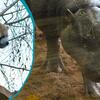Dr Sarah Jayne Smith (zoo, aquarium and wildlife veterinarian) on why we should let dung beetles into our lives:
I remember the first time I learnt about dung beetles. Seven years old, sitting cross legged on the floor at school and studying ancient Egyptian history. The teacher was telling us about the god, Khepri; a dung beetle who rolls the sun across the sky in the morning. I wonder if there is another universe in which I am an archaeologist, historian or a storyteller? In which I didn’t do a deep dive into trying to figure out the logistics of how a small beetle could roll a ball of poo, that was up to 70 times its own weight. But here we are... and fortunately for seven-year-old me, dung beetles are not confined to ancient Egypt. I soon found that there were species much closer to home to learn about.
There are approximately 50 different species of dung beetle in Great Britain and Ireland. Unlike species from warmer climes, our native species are not ‘rollers.’ They can be split into two groups: ‘dwellers’, beetles who live their entire lives within dung and ‘tunnelers’, beetles who spend most of their time just below ground, taking dung with them.
Both groups of beetles play the same vital role in our ecosystems. By burying dung, they rearrange the soil structure and introduce nutrients, which encourages healthy plant growth.
This reworking also increases soil permeability which reduces surface runoff and flood risk. When they remove dung from pastures, dung beetles remove the habitats that are required for many parasites and pest flies to complete their lifecycles, and they help reduce methane emissions.
In addition to this dung beetles and their larvae are a food source for other native species such as greater horseshoe bats and the Eurasian curlew.
When you consider all the jobs that dung beetles have, it is perhaps not difficult to see why the ancient Egyptians associated them with creation and the renewal of life.
However, over 50% of our native dung beetle species are in trouble. 38% are considered nationally scarce, near threatened, vulnerable or critically endangered. 8% are regionally extinct and 6% are presumed extinct. There are many threats to dung beetles, including the loss of farming habitat and the use of chemical fertilisers. However, one of the biggest threats to dung beetles is a necessary practice that, as a zoo vet, I am complicit in – the environmental and medical management of parasites.
Ivermectin, a common parasite treatment, can persist in dung and soil, remaining toxic to non-target invertebrates, for at least four months. The removal of dung from paddocks, a practice aimed at reducing dependence on medication, removes the habitat needed for dung beetles. As a vet, I have seen the impact that severe parasite burdens can have on animals, but the environmental impact of managing them is something that I cannot ignore. And so, my fascination with dung beetles has evolved into a passion for holistic parasite management.
I strongly believe that the plight of native dung beetles is something that all zoological collections should be concerned about. These tiny creatures are as fascinating and charismatic as the exotic species that many of us look after and play a vital role in ecosystem health. They deserve interest and care in their own right, and we should be championing their protection as much as we champion the protection of the animals in our care.
If invertebrates aren’t your thing, then you should care about them because of the impact their disappearance can have further up the food chain. Greater horseshoe bat numbers have declined by 90% in the last 100 years and the Eurasian curlew was added to the IUCN red list in 2015, in part linked to the decline in invertebrate numbers.
If you are a hoof stock keeper, you should care about dung beetles, because their work in maintaining soil health promotes the growth of plants which your animals eat to survive. They also destroy the conditions needed for many parasites to complete their lifecycle, thus preventing clinical disease. And as we move into a period of climate uncertainty and the associated increased risk of vector-borne disease such as bluetongue and avian malaria, we should all care about dung beetles because of their ability to increase soil permeability, reducing pools of stagnant water where midges like to congregate.
This summer BIAZA is inviting all members to participate in ‘BIAZA Project DUNG’ - a survey of zoos to identify the species of dung beetles present and to record their numbers. It is an excellent opportunity for your staff to gain a new skill and improve understanding of these species, which can be used to boost awareness amongst visitors. A better understanding of the beetles that already live on your sites will empower your staff to manage habitats in a way that protects these species and can contribute to your organisation's conservation impact. You can register your organisation by emailing [email protected] and following the steps found here.
As we move into the final throes of summer, there really can be no better way of honouring the Egyptian sun deity than by working to protect its UK cousin.
- Dr Sarah Jayne Smith (zoo, aquarium and wildlife veterinarian, International Zoo Veterinary Group)
All blogs reflect the views of their author and are not necessarily a reflection of BIAZA's position
-
News
 Belfast Zoo helps to bring Christmas joy to Children’s Hospital 19th December, 2025Belfast Zoo joined the Lord Mayor of Belfast, Councillor Tracy Kelly, on Monday (15th December) to help bring festive cheer to the Royal Belfast Hospital…
Belfast Zoo helps to bring Christmas joy to Children’s Hospital 19th December, 2025Belfast Zoo joined the Lord Mayor of Belfast, Councillor Tracy Kelly, on Monday (15th December) to help bring festive cheer to the Royal Belfast Hospital… -
News
 Colchester Zoological Society welcomes new arrivals 19th December, 2025This December, Colchester Zoological Society (CZS) welcomed some exciting new arrivals! A young male pygmy hippo, Mikolas, from Zoo Dvur Kralove…
Colchester Zoological Society welcomes new arrivals 19th December, 2025This December, Colchester Zoological Society (CZS) welcomed some exciting new arrivals! A young male pygmy hippo, Mikolas, from Zoo Dvur Kralove… -
News
.png?w=100&h=100&zc=1&f=jpeg&hash=8d175f93cde920c5ba23c8ea7f92e55a) Blog: Understanding the human side of zoos 16th December, 2025Why are zoo researchers increasingly looking to social science? Dr Nieky van Veggel explains the significance of understanding the human dimension…
Blog: Understanding the human side of zoos 16th December, 2025Why are zoo researchers increasingly looking to social science? Dr Nieky van Veggel explains the significance of understanding the human dimension…



